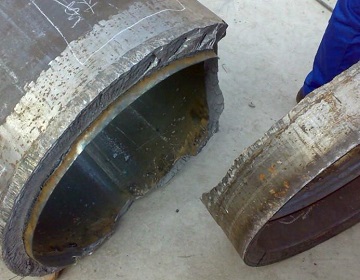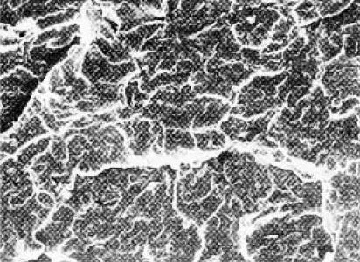What’s Hydrogen-Induced Cracking (HIC) and HIC Test?
Hydrogen-induced craking (HIC), also referred to as hydrogen stress cracking or static fatigue, is a typical form of hydrogen embrittlement. It is characterized by the brittle fracture of a normally ductile alloy under sustained load in the presence of hydrogen. More often, fracture occurs at sustained loads below the yield strength of the material. This cracking mechanism depends on the hydrogen fugacity, strength level of the material, heat treatment/ microstructure, applied stress, and temperature. Many ferrous and nonferrous metals may be susceptible to hydrogen damage in both aqueous or gaseous hydrogen-bearing environments. These metals includes carbon steel, alloy steel, and nickel & nickel alloy, etc.

The hydrogen-induced cracking failure of an API 5L X60 line pipe.
For many steels, a threshold stress exists below which hydrogen induced cracking does not occur. This threshold is a function of the strength level of the steel and the specific hydrogen-bearing environment. Therefore, threshold stress or stress intensity for HIC is not considered a material property. Generally, the threshold stress decreases as the yield strength and tensile strength of an alloy increase. Hydrogen induced cracking is associated with absorption of hydrogen and a delayed time to failure (incubation time) during which hydrogen diffuses into regions of high triaxial stress. The HIC may promote one mode of fracture in an alloy rather than another form normally observed in benign environments. Thus, there are a variety of cracking patterns that can be observed; however, hydrogen stress cracking usually produces sharp singular cracks in contrast to the extensive branching observed for stress cracking corrosion(SCC). The catastrophic cracking of steels in hydrogen sulfide (H2S) environments referred to as sulfide stress cracking is a special case of hydrogen stress cracking.

The microstructure at the HIC fracture of a mild carbon steel. The white hairlines in the photo are the HIC fracture zone.
In order to evaluate the resistance to hydrogen-induced cracking of pipeline and pressure vessel steel, standard test shall be conducted in accordance with NACE TM0284. The steel specimens shall be immersed into test solutions at the temperature 25±3°C [77±5°F]. There are two standard test solutions: Solution A – a sodium chloride, acetic acid (NaCl, CH3COOH) solution saturated with H2S at ambient temperature and pressure; Solution B – a synthetic seawater solution saturated with H2S at ambient temperature and pressure. The test duration shall be 96 hours. After testing, the specimens shall be taken out of the test solution and cracks shall be measured. Three main parameters shall be calculated to evaluate the steel’s resistance to HIC: crack sensivity ratio(CSR), crack length ratio(CLR), crack thickness ration(CTR).
Metals-Piping supplies a variety of HIC-resistant steels for piping industry. These steels includes API 5L Grade X60, X65, X70; ASTM A516 Grade 60, 65, 70; ASTM A420 Gr. WPL6; ASTM A333 Gr.6; ASTM A860 WPHY60, WPHY65, WPHY70; ASTM A694 Gr. F60, F65, F70, etc.
